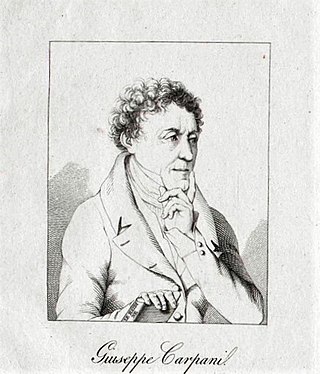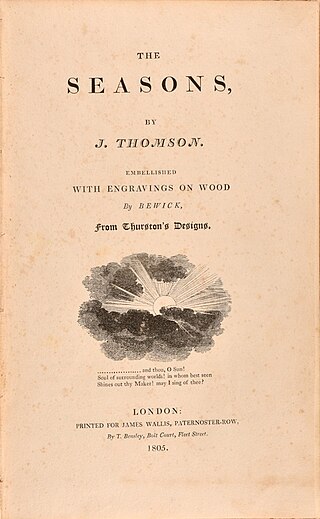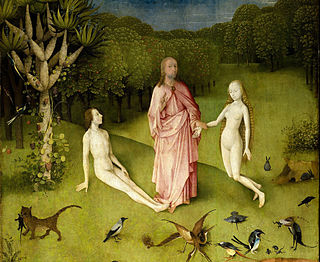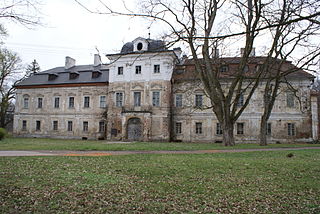
The Creation is an oratorio written in 1797 and 1798 by Joseph Haydn, and considered by many to be one of his masterpieces. The oratorio depicts and celebrates the creation of the world as described in the Book of Genesis.

Johann Peter Salomon was a German violinist, composer, conductor and musical impresario. Although he was an accomplished violinist, he is best known for bringing Joseph Haydn to London and for conducting the symphonies that Haydn wrote during his stay in England. He also knew and worked with Wolfgang Amadeus Mozart and Ludwig van Beethoven.

"Gott erhalte Franz den Kaiser" was a personal anthem to Francis II, Emperor of the Holy Roman Empire and later of the Austrian Empire, with lyrics by Lorenz Leopold Haschka (1749–1827) and music by Joseph Haydn. It is sometimes called the "Kaiserhymne". Haydn's tune has since been widely employed in other contexts: in works of classical music, in Christian hymns, in alma maters, and as the tune of the "Deutschlandlied", the national anthem of Germany.

Gottfried Freiherr van Swieten was a Dutch-born Austrian diplomat, librarian, and government official who served the Holy Roman Empire during the 18th century. He was an enthusiastic amateur musician and is best remembered today as the patron of several great composers of the Classical era, including Joseph Haydn, Wolfgang Amadeus Mozart, and Ludwig van Beethoven.

The Seven Last Words of Our Saviour on the Cross is an orchestral work by Joseph Haydn, commissioned in 1786 for the Good Friday service at Oratorio de la Santa Cueva in Cádiz, Spain. Published in 1787 and performed then in Paris, Rome, Berlin and Vienna, the composer adapted it in 1787 for string quartet, approved a version for solo piano in the same year, and finally adapted it in 1796 as an oratorio.
The Symphony No. 75 in D major is a symphony composed by Joseph Haydn between 1779 and 1781.
The ethnicity of the composer Joseph Haydn was a controversial matter in Haydn scholarship during a period lasting from the late 19th to the mid-20th century. The principal contending ethnicities were Croat and German. Mainstream musical scholarship today adopts the second of these two hypotheses.
Mathias Haydn was the father of two famous composers, Joseph and Michael Haydn. He worked as a wheelwright in the Austrian village of Rohrau, where he also served as Marktrichter, an office akin to village mayor.
Count Karl Joseph of Morzin (1717–1783) was a Bohemian aristocrat from the Morzin family, remembered today as the first person to employ the composer Joseph Haydn as his Kapellmeister, or music director. The first few of Haydn's many symphonies were written for the Count.

Joseph Haydn's Symphony No. 31 in D major, Hob. I/31, was composed in 1765 for Haydn's patron Nikolaus Esterházy. It is nicknamed the "Hornsignal Symphony", because it gives a prominent role to an unusually large horn section of four players. Probably because of its prominent obbligato writing for the horns, in Paris, the publisher Sieber published this symphony as a "symphonie concertante" around 1785.

Giuseppe Carpani was an Italian man of letters. He is remembered in large part for his role in the history of classical music: he knew Haydn, Mozart, Salieri, Beethoven, and Rossini, and served them in various ways as poet, translator, and biographer.

The Seasons is a series of four poems written by the Scottish author James Thomson. The first part, Winter, was published in 1726, and the completed poem cycle appeared in 1730.
The Gesellschaft der Associierten was an association of music-loving noblemen centered in Vienna and founded by Baron Gottfried van Swieten in 1786. The society sponsored concerts, often reviving music from the past, and also commissioned new works.
This article discusses the influence of folk music on the work of the composer Joseph Haydn (1732–1809).

The Creation, the oratorio by Joseph Haydn, is structured in three parts. He composed it in 1796–1798 on German text as Die Schöpfung. The work is set for soloists, chorus and orchestra. Its movements are listed in tables for their form, voice, key, tempo marking, time signature and source.
David Wyn Jones FLSW is a British musicologist. He is an expert on music of the Classical period, including that of Haydn and Beethoven.

Il ritorno di Tobia is an oratorio in two parts composed in 1775 by Joseph Haydn. The work is the first oratorio the composer wrote and, according to Jones, was "his most extended and ambitious composition up to that time".

The Tonkünstler-Societät was a benevolent society for musicians in Vienna, which lasted from the mid-18th century to the mid-20th. Its purpose was "to support retired musicians and their families". Beginning in 1772, the Society mounted a series of benefit concerts, often with large forces of performers, at which were performed works by leading Classical-period composers, including Joseph Haydn, Wolfgang Amadeus Mozart, and Ludwig van Beethoven.

The Morzin Palace is a country estate in Dolní Lukavice, Czech Republic.












